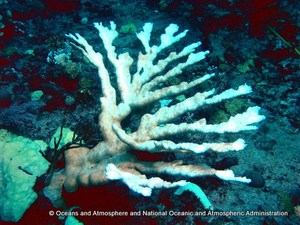CAIRNS, Australia 9 July 2012. “Coral reefs are important ecosystems of ecological, economic and cultural value yet they are in decline worldwide due to human activities,” said the Consensus Statement released recently during the opening of the 2012 International Coral Reef Symposium (ICRS) held in Cairns, Australia. “Land-based sources of pollution, sedimentation, overfishing and climate change are the major threats, and all of them are expected to increase in severity.”

Continuous bleaching of corals due to warming temperatures eventually lead to coral death. This impacts the marine ecosystem negatively.
The international Coral Reef Science Community urges governments from all over the world “to take action for the preservation of coral reefs for the benefit of present and future generations.”
The Consensus Statement has been signed by about 2,600 scientists from all over the globe, including about 25 from the Philippines. “Approximately 25-30% of the world’s coral reefs are
already severely degraded by local impacts from land and by over-harvesting,” the statement said.
“There is no debate among marine scientists that climate change is for real,” said Dr. Robert H. Richmond, president of the International Society for Reef Studies. Coral reefs are among those that are greatly affected by the global warming phenomenon.
A sudden or abrupt change in temperature is bad for corals. “It leads to stress that cause coral bleaching, and eventually, death of corals. “Bleaching is not a good thing,” explained Dr. Terry Hughes, a distinguished professor at James Cook University. “Thermal stress due to global warming is not good.”

Terry Hughes: Coral bleaching is not a good thing.
According to Dr. Hughes, as global warming intensifies, coral bleaching would also increase at an unprecedented level. “Bleaching events are expected to increase in terms of frequency,” said Dr. Hughes, who has been a Fellow of the Australian Academy of Science since 2001.
“The surface of the world’s oceans has warmed by 0.7°Centigrade, resulting in unprecedented
coral bleaching and mortality events,” said the statement, which was drafted by a working group
of eminent scientists, brought together under the auspices of The Center for Ocean Solutions.
In a series of journals some years back, Science reported that climate change could trigger the death of coral reefs, with coral bleaching being the clearest sign.
Corals grow in the warm waters, but many of them are near the limits of their tolerance for high temperatures. Bleaching is a breakdown of a “complex biological system” that corals have evolved in order to survive. Each coral formation is a colony of hundreds or thousands of tiny organisms (known as polyps) that jointly build a skeleton that forms the reef. The outside layer of each coral polyp is inhabited by tiny one-celled plants scientists called zooxanthellae. It is these organisms that give the coral its bright colors, and when expelled due to warmer water or some other stress, coral appears bleached (that is, go pale or snowy-white).
Without zooxanthellae, the coral cannot survive for long. “When subjected to extreme stress (like high temperature of surface water),” explains Worldwatch Institute’s John C. Ryan, “corals jettison the colorful algae they live in symbiosis with, exposing the white skeleton of dead coral beneath a single layer of clear living tissue. If the stress persists, the coral dies.”
In the first months of 2002, a wave of bleaching swept coral reefs around the world with scientists linking the events to climate change. The majority of bleaching records came from the Great Barrier Reef in Australia with others from reefs in countries including the Philippines, Indonesia, Malaysia, Japan, Palau, the Maldives, Tanzania, the Seychelles, Belize, Ecuador and off the Florida coast of the United States.

Six countries have signed the Coral Triangle Initiative to combat coral bleaching and other marine-related issues.
In 2010, as much as 95% of the corals in the Philippines suffered bleaching after a warming
event. “The bleaching has been observed at many other sites around the Philippines featuring
mass mortality of corals,” a news report said.
Also suffering from bleaching are coral reefs from nearby Coral Triangle Region, which is
globally recognized as the epicenter of marine biodiversity. It is home to about 76% of the
world’s coral species.
Six countries have signed and agreed to a regional plan called the Coral Triangle Initiative, a
collaboration that aims to protect this important area. The member countries are Indonesia, the
Philippines, Malaysia, Papua New Guinea, Solomon Islands, and Timor-Leste. Although not part
of the initiative, the coral triangle region – which contains more than 86,500 square kilometers of coral reef area – also includes Brunei and Singapore.
“This abundant marine ecosystem is now at risk,” said the United States Agency for International evelopment (USAID) in a statement. “Unsustainable fishing, rapid population growth, and the effects of climate change are not only damaging the environment, but also threatening the food security of those who depend on the valuable natural resources in the region.”
USAID said the coastal ecosystems in the region support the livelihoods of over 340 million people spread across the six countries. In the Philippines, for instance, 50 million people depend on coral reefs and associated ecosystems for food and livelihood.
There is no glimmer of hope. By the end of this century, the consensus statement said with the current rate of carbon dioxide emissions, the sea surface temperatures will further become hotter by at least 2-3°Centigrade. Not only that, sea-level will rise by as much as 1.7 meters. Storm frequency and/or intensity will most likely increase.
“Across the globe, these problems cause a loss of reef resources of enormous economic and cultural value,” the consensus statement concluded. “A concerted effort to preserve reefs for the future demands action at global levels, but also will benefit hugely from continued local protection.”